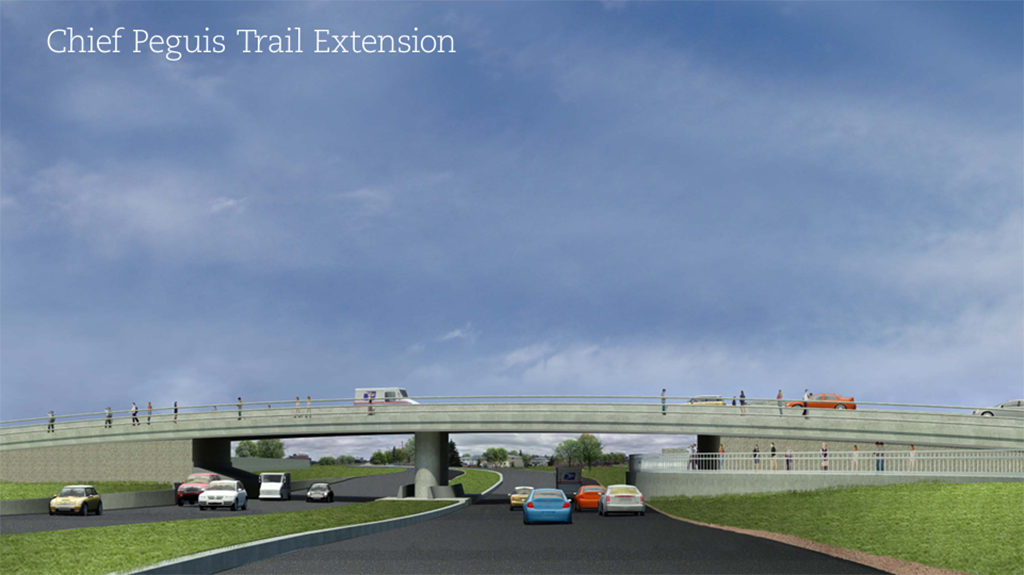The estimated price tag of the westward extension of Chief Peguis Trail (CPT) has increased by hundreds of millions of dollars, but Winnipeg officials say the project offers big economic benefits for the city and should still go ahead.
A recent report estimates building the 10-kilometre extension, from Main Street westward to Brookside Boulevard, will now cost $755.3 million.
That’s a big increase since 2019, when the city estimated it would cost $449 million.
CPT currently runs from Lagimodiere Boulevard, a long north-south street in the eastern part of Winnipeg, westward over the Red River to Main Street, an equally long north-south thoroughfare.
The extension is intended to provide a continuous link between the east and west sections of the Perimeter Highway (a 56-mile ring road around Winnipeg for through traffic) via CentrePort Canada Way.
Proponents say it would shave six to 11 minutes in travel time for east-west drivers across the northern part of Winnipeg.
They also say it would improve access to industrial parks near the airport and further develop the region’s road network.
Mayor Scott Gillingham says Winnipeg needs the project to facilitate trade and development in the city’s northwest.
Extending CPT will increase residential development by as many as 15,000 new homes, Gillingham says, and open up land for new commercial development too.
Among the anticipated economic benefits are more efficient traffic flows, added pedestrian and cycling infrastructure, reduced fuel consumption and lower greenhouse gas emissions.
A cost-benefit analysis in the report estimates the net economic and social benefits from building the extension to be $98 million over 50 years.
Critics of the project say it is too expensive and that it would be better if the city spent the money on providing better municipal services and renewing existing facilities.
However, Chris Lorenc, president and CEO of the Manitoba Heavy Construction Association, says any discussions about the extension of CPT need to take into consideration “the current trade and economic context.”
“The tariff war with the U.S. has underscored the necessity of reaching new or expanding existing global trade markets, to alleviate the country’s dependence on the U.S. for trade,” says Lorenc. “More than three-quarters of Canada’s exports go to the U.S.”
Canada must invest in trade corridors and gateways to repair its damaged reputation as a reliable global trade partner, Lorenc says.
The CPT extension is the “very type of project that speaks to branding ourselves as trade- and economic-investment ready,” he says. “Chief Peguis Trail clearly merits federal and provincial financial support.”
The extension will bring CPT to the eastern boundary of CentrePort Canada, says Carly Edmundson, president and CEO of the 20,000-acre trimodal inland port and foreign trade zone.
“Extending CPT will benefit CentrePort by enhancing its connectivity and supporting the region’s economy,” says Edmundson. “CPT will improve access to industrial parks and make it easier for companies to ship and move their products across the country.”
Edmundson says there are plans in the future to further extend CPT right into CentrePort.
Approximately 1,000 companies are located at CentrePort Canada, which lies adjacent to the Winnipeg airport. The industries they represent include transportation and distribution, warehousing, agribusiness and aerospace.
Ahmed Shalaby, professor of civil engineering at the University of Manitoba, says although the project will improve the connectivity of the road network and open new land for development, it could also create problems.
“Without investment in transit, more suburban land development will add more pressure and congestion on the nearly saturated road network,” says Shalaby.
He says Winnipeg has outgrown its current road network and needs to take a serious look at additional rapid transit lines and eventually passenger rail.
“Among the top 10 cities in Canada, Winnipeg is the only one without a plan to develop passenger rail, without a plan to build additional bus rapid transit routes (we have one) in a reasonable timeframe, and without any expressways crossing the city,” says Shalaby.








Recent Comments
comments for this post are closed